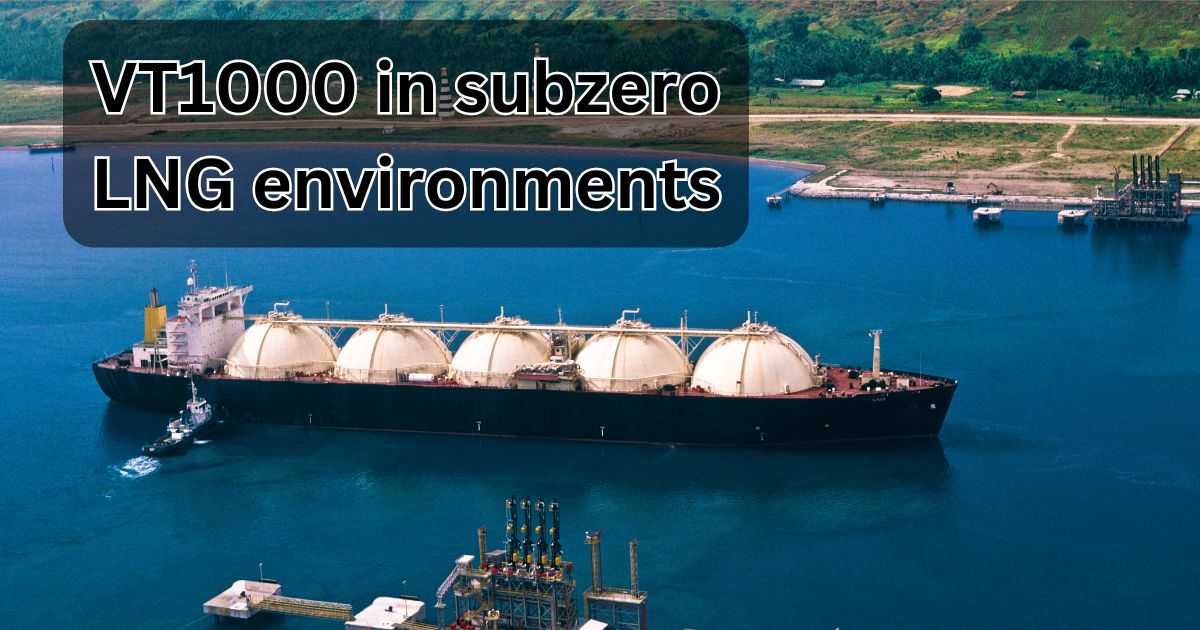The VT1000 is a cutting-edge technology designed for high-performance applications in demanding environments, including the VT1000 in Subzero LNG Environment. It is renowned for its robustness and adaptability, making it suitable for various industrial uses. The VT1000 system incorporates advanced materials and engineering techniques to ensure reliable operation under extreme conditions. Its primary features include a high tolerance for temperature fluctuations, precise control mechanisms, and enhanced durability. These attributes make the VT1000 an ideal choice for sectors where performance and reliability are critical. In the realm of liquefied natural gas (LNG) operations, where temperatures can plunge to subzero levels, the VT1000’s design and functionality are put to the test. Its ability to maintain performance and efficiency in such harsh conditions underscores its engineering excellence. The VT1000 is not just a technological marvel but a testament to the advancements in equipment designed for extreme environments.
Understanding LNG Environments
Liquefied Natural Gas (LNG) is natural gas that has been cooled to a liquid state for ease of storage and transport. LNG is a clear, colorless liquid at extremely low temperatures, typically around -160°C (-260°F). The process of liquefaction reduces the gas volume significantly, making it more economical to transport and store.
Subzero LNG environments are characterized by their extreme cold temperatures, which pose unique challenges for equipment used in these settings. The harsh conditions can affect both the physical and chemical properties of materials, leading to potential performance issues. Understanding these environments is crucial for designing equipment that can withstand the rigors of LNG operations. The VT1000’s ability to operate efficiently in such conditions highlights its advanced engineering and suitability for LNG applications.
VT1000: Technical Specifications
Design and Build of VT1000
The VT1000 is engineered with a focus on durability and performance, particularly in extreme conditions. Its design incorporates materials that are resistant to cryogenic temperatures, ensuring that the equipment remains functional and reliable even in subzero LNG environments. The use of high-strength alloys and specialized coatings protects the VT1000 from the effects of extreme cold and potential chemical interactions with LNG.
The build of the VT1000 includes features such as reinforced structural components, advanced thermal insulation, and precision-engineered seals. These elements work together to maintain the equipment’s integrity and operational efficiency in challenging conditions. The VT1000’s design not only addresses the immediate needs of LNG operations but also anticipates future challenges, making it a forward-thinking solution for industrial applications.
Performance Metrics
When evaluating the VT1000’s performance, several metrics are critical. Operational efficiency is one of the foremost indicators, reflecting how well the equipment performs its intended functions without unnecessary energy consumption or wear. The VT1000 excels in this area, delivering reliable performance and consistent results even under extreme temperatures.
Durability and reliability are also key performance metrics for the VT1000. The equipment is built to withstand prolonged exposure to harsh conditions, with minimal maintenance requirements. This robustness translates into longer operational lifespans and reduced downtime, which are essential for maintaining productivity in LNG environments. The VT1000’s performance metrics underscore its effectiveness as a high-performance solution for demanding industrial applications.
Challenges of Subzero LNG Environments
Extreme Cold Conditions
Operating in subzero LNG environments presents significant challenges for equipment. The extreme cold can lead to various issues, such as material brittleness, reduced flexibility, and potential failure of components. Equipment must be designed to handle these conditions to ensure reliable performance and safety.
The impact of extreme cold on equipment includes changes in material properties and potential for thermal stress. For example, metals can become more brittle at low temperatures, increasing the risk of fractures or breakages. Additionally, the performance of lubricants and other fluids may be adversely affected by the cold, leading to potential operational issues. Addressing these challenges requires advanced engineering solutions and robust design considerations, such as those incorporated in the VT1000.
Cryogenic Temperatures and Their Effects
Cryogenic temperatures, such as those found in LNG environments, have profound effects on materials and equipment. At these temperatures, materials can exhibit significantly different properties compared to their behavior at higher temperatures. For instance, metals may become more susceptible to cracking, while insulation materials may lose their effectiveness.
The thermal conductivity of materials also changes at cryogenic temperatures. Some materials that are normally effective insulators at higher temperatures may become less effective when exposed to extreme cold. This can impact the overall efficiency of equipment and necessitate the use of specialized insulation techniques. The VT1000’s design takes these factors into account, ensuring that it can operate effectively despite the challenges posed by cryogenic temperatures.
VT1000 in Subzero LNG Environments
Adaptations for Cold Environments
The VT1000 has been specifically adapted for operation in subzero LNG environments through various engineering modifications. One of the key adaptations is the use of materials designed to withstand extreme cold without compromising performance. These materials are selected for their ability to retain their strength and flexibility even at cryogenic temperatures.
Insulation techniques are also crucial for the VT1000’s performance. Advanced thermal insulation materials and design features help maintain operational temperatures and protect sensitive components from the effects of extreme cold. The VT1000’s engineering includes features such as thermal blankets and specialized coatings to enhance its resilience in LNG environments. These adaptations ensure that the VT1000 remains reliable and effective, even in the harshest conditions.
Performance in Cryogenic Conditions
The VT1000 has demonstrated impressive performance in cryogenic conditions through various real-world applications. Case studies reveal that the equipment maintains its efficiency and reliability, providing consistent results even in the most challenging environments. Comparative analyses with other technologies highlight the VT1000’s superior performance, emphasizing its suitability for LNG applications.
For example, in LNG processing plants, the VT1000 has been shown to perform effectively without experiencing significant degradation in performance or durability. This real-world performance reinforces the VT1000’s status as a leading solution for subzero LNG environments. The equipment’s ability to handle extreme cold while delivering reliable results underscores its advanced engineering and suitability for industrial applications.
Also Read: How to Protect Walls from Dog During Storm
Installation and Maintenance
Installation Best Practices
Proper installation is crucial for ensuring the VT1000’s performance and longevity in subzero LNG environments. Site preparation involves assessing the environmental conditions and making any necessary modifications to accommodate the equipment. Handling and storage procedures must also be followed to prevent damage during transportation and installation.
Installation best practices include ensuring that the equipment is securely mounted and properly insulated. The use of appropriate tools and techniques is essential for achieving optimal performance and reliability. By adhering to these best practices, operators can ensure that the VT1000 operates effectively and efficiently in its intended environment.
Maintenance Considerations
Routine maintenance is vital for keeping the VT1000 in optimal condition, particularly in demanding LNG environments. Regular checks should be performed to identify and address any potential issues before they escalate. Maintenance procedures may include inspecting and replacing worn components, checking insulation integrity, and verifying overall equipment performance.
Troubleshooting common issues is also an important aspect of maintenance. Identifying potential problems, such as thermal stress or material degradation, and implementing corrective measures can prevent equipment failures and reduce downtime. By maintaining the VT1000 according to established guidelines, operators can ensure its continued effectiveness and reliability in subzero LNG environments.
Safety and Compliance
Safety Standards for LNG Environments
Safety is a paramount concern in LNG environments, where the risks associated with extreme cold and flammable gases must be carefully managed. Various safety standards and regulations govern the operation of equipment in these environments, ensuring that all safety requirements are met.
Compliance with safety standards involves adhering to regulations related to equipment design, operation, and maintenance. For the VT1000, this means ensuring that the equipment meets all relevant safety criteria and is equipped to handle the specific challenges of LNG environments. By following these standards, operators can minimize risks and ensure safe and efficient operation of the VT1000.
Risk Management
Effective risk management is essential for operating equipment in LNG environments. Identifying potential hazards, such as extreme cold and potential chemical reactions, is the first step in managing risks. Implementing mitigation strategies, such as regular maintenance and monitoring, can help address these risks and prevent incidents.
Risk management strategies for the VT1000 include conducting thorough risk assessments, implementing safety protocols, and training personnel to handle emergencies. By proactively addressing potential hazards, operators can enhance the safety and reliability of the VT1000 in subzero LNG environments.
Benefits of Using VT1000 in LNG Environments
Operational Efficiency
The VT1000 offers significant operational efficiency benefits in LNG environments. Its advanced design and engineering enable it to perform effectively even under extreme conditions, leading to cost savings and improved overall performance. The equipment’s ability to maintain high efficiency levels reduces energy consumption and operational costs, contributing to a more economical and sustainable operation.
Enhanced reliability is another key benefit of the VT1000. Its durability and resistance to extreme cold ensure that it operates consistently without frequent breakdowns or maintenance issues. This reliability translates into increased productivity and reduced downtime, further enhancing the overall efficiency of LNG operations.
Enhanced Reliability
The VT1000’s enhanced reliability is a major advantage in subzero LNG environments. Its robust design and high-quality materials ensure that it remains functional and effective even in the most challenging conditions. This reliability is critical for maintaining continuous operations and minimizing disruptions.
The equipment’s long operational lifespan and minimal maintenance requirements contribute to its overall reliability. By reducing the need for frequent repairs or replacements, the VT1000 helps operators maintain smooth and efficient operations. Its reliability underscores its value as a dependable solution for LNG environments.
Future Developments
Innovations in VT1000 Technology
Future developments in VT1000 technology are likely to focus on further enhancing its performance and capabilities. Innovations may include improvements in materials and design to increase its resilience and efficiency in subzero LNG environments. Advances in technology could also lead to the incorporation of new features and functionalities, expanding the VT1000’s range of applications.
Emerging trends in equipment technology, such as the integration of smart systems and advanced monitoring capabilities, may also be incorporated into future iterations of the VT1000. These innovations have the potential to enhance its performance, reliability, and ease of use, further solidifying its position as a leading solution for industrial applications.
Research and Development
Ongoing research and development efforts are crucial for advancing VT1000 technology and addressing the evolving needs of LNG environments. Studies focused on improving material properties, enhancing performance, and optimizing design are key to driving innovation in this field.
Future research may explore new materials and technologies to further enhance the VT1000’s capabilities in cryogenic conditions. By investing in research and development, manufacturers can ensure that the VT1000 remains at the forefront of technology and continues to meet the demands of challenging industrial environments.
Case Studies
Successful Implementations
Several successful implementations of the VT1000 in subzero LNG environments highlight its effectiveness and reliability. For example, in a major LNG processing facility, the VT1000 was used to enhance operational efficiency and maintain performance under extreme cold conditions. The equipment’s ability to deliver consistent results and withstand harsh environments contributed to the success of the operation.
Another case study involves the use of the VT1000 in a remote LNG storage facility, where its durability and reliability were crucial for maintaining continuous operations. The equipment’s performance in these challenging conditions underscores its suitability for a wide range of industrial applications.
Lessons Learned
Lessons learned from implementing the VT1000 in LNG environments provide valuable insights into its performance and effectiveness. Challenges faced during these implementations include dealing with extreme cold and ensuring proper maintenance and operation. Solutions implemented to address these challenges have led to improved performance and reliability.
For example, adaptations made to the VT1000’s design and installation procedures have contributed to its success in subzero LNG environments. These lessons highlight the importance of ongoing evaluation and refinement to ensure that the equipment continues to meet the demands of its applications.
Conclusion
In summary, the VT1000 in Subzero LNG Environment is a highly advanced technology designed to operate effectively under extreme cold conditions. Its robust design, performance metrics, and specific adaptations for cold conditions make it a reliable and efficient solution for industrial applications. The equipment’s ability to handle extreme cold, combined with its operational efficiency and durability, underscores its value in LNG environments.
The successful implementation of the VT1000 in Subzero LNG Environment in various case studies demonstrates its effectiveness and reliability. Ongoing research and development efforts will continue to drive innovations and improvements in VT1000 technology, ensuring its continued relevance and performance in challenging industrial environments.
Looking to the future, the VT1000 in Subzero LNG Environment is poised to benefit from ongoing advancements in technology and materials. Innovations in equipment design and functionality will further enhance its performance and capabilities in subzero LNG environments. As the demands of industrial applications continue to evolve, the VT1000 will remain a key player in delivering reliable and efficient solutions for the challenges of LNG environments.
With its proven track record and commitment to excellence, the VT1000 is well-positioned to continue leading the way in cryogenic equipment technology. The future holds promising opportunities for further advancements, ensuring that the VT1000 in Subzero LNG Environment remains a valuable asset for industrial operations in subzero LNG environments.










